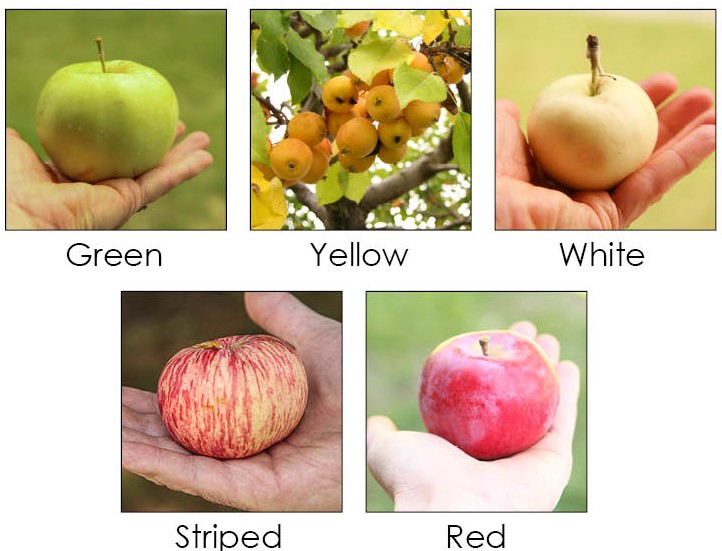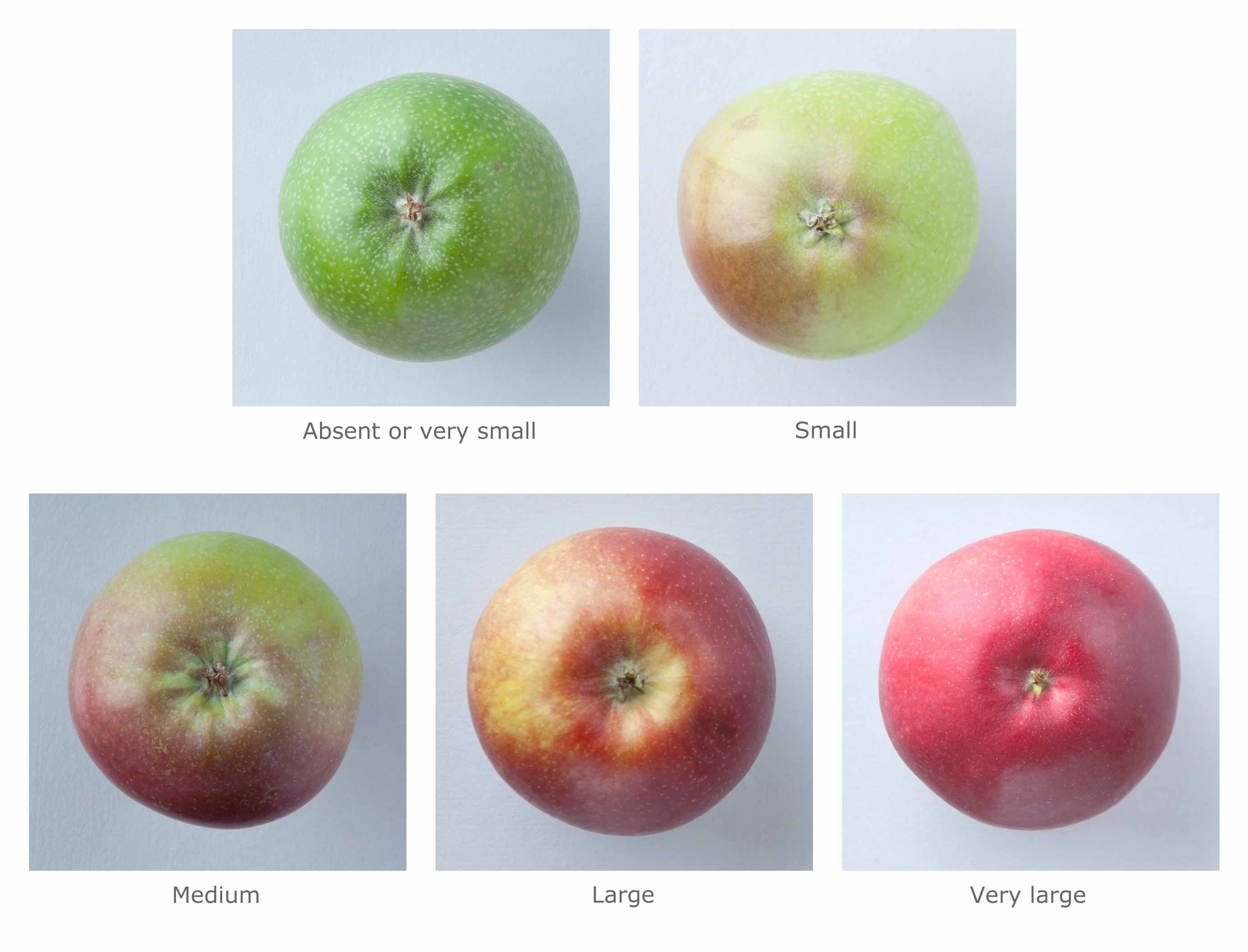Apple Color
There are three criteria used to evaluate apple color, the overall appearance of the apple, the ground color and the over color. To use this category, your apple sample should include multiple ripe apples from a sunny location on the tree to ensure no shading has affected the apple appearance or flavor. Some apples may fit into multiple categories with in a single criteria. Using the additional criteria of size, shape and harvest will help eliminate other possibilities and narrow your search.
Overall Appearance
The criteria considers the overall appearance of the apple at first glance. The categorization below is unique to Montana apples for use of this key and is generally adapted from the Bultitude Group method developed by John Bultitude. Is it green, yellow, red, white or striped?

Green
Green, sometimes with a brownish orange or red blush. Smooth skinned, usually culinary varieties but also sweet. Often unripe yellow apples will be placed in this group. If you are unsure of your samples maturity look at apples in both categories.
Yellow
Yellow apples, smooth skinned, sometimes with red blush, can become almost white as they ripen. Often early apples for culinary use.
White
Creamy to white apples with nearly transluscent skin. Often early apples.
Striped
Carmine or red striped, usually against a yellow, white or pale green ground color (background). Smooth skinned. Often sweet apples, but sometimes acid or dual purpose. Can also be flushed with minimal striping.
Red
Mainly red (over ¾ of apple), green or yellow background, sometimes vaguely striped.
| Cultivar | Green | Yellow | Striped | White | Red |
|---|---|---|---|---|---|
| Alexander | X | X | |||
| Dolgo | X | ||||
| Duchess of Oldenburg | X | ||||
| Fameuse | X | X | |||
| Hibernal | X | ||||
| McIntosh | X | ||||
| Northwest Greening | X | ||||
| Transcendent | X | ||||
| Wealthy | X | ||||
| Whitney | X | ||||
| Wolf River | X | X | |||
| Yellow Transparent | X | X |
Ground Color
The ground color is the primary color of the apple behind the flush (area exposed to light also called over color). In some cases it might be the color of the whole apple when other colors are not present. It is often green to yellow to a washed out variation of either or nearly white. Compare your ripe apple sample with the examples below to determine the ground color of your apple, then find matching cultivars in the subsequent table.

Examples of various ground colors in apple. Photo provided by fruitid.com.
|
Cultivar
|
Ground Color Not Visible
|
Green
|
Yellow Green
|
Whitish Green
|
Yellow
|
Whitish Yellow
|
|---|---|---|---|---|---|---|
|
|
X
|
X
|
|
|
|
|
|
X
|
|
|
|
X
|
|
|
|
|
|
X
|
X
|
X
|
X
|
|
|
|
X
|
X
|
X
|
|
|
|
|
|
X
|
X
|
X
|
|
|
|
|
|
X
|
X
|
|
|
|
|
|
X
|
|
|
|
|
|
|
|
|
|
|
|
X
|
|
|
|
|
X
|
X
|
X
|
|
|
|
|
|
|
|
|
|
|
|
|
|
X
|
X
|
X
|
X
|
X
|
|
|
X
|
|
|
|
|
|
Over Color
The over color describes the flush or area of the apple colored by sunlight. Apples from the interior, shaded areas of the tree or immature fruit will not always display an over color so be sure you are using a quality sample. In addition to the over color, the extent of over color can also be used to identify the apple. Use the photos and tables below to examine your apple sample's over color.
Hue of Over Color

Examples of apple over color. Photo provided by fruitid.com.
| Cultivar | Gold | Orange Red | Pink Red | Red | Purple Red | Brown Red |
|---|---|---|---|---|---|---|
| Alexander | X | X | ||||
| Dolgo | X | X | X | |||
| Duchess | X | X | ||||
| Fameuse | X | |||||
| Hibernal | X | |||||
| McIntosh | X | X | ||||
| Northwest Greening | X | |||||
| Transcendent | X | X | X | X | ||
| Wealthy | X | X | X | |||
| Whitney | X | |||||
| Wolf River | X | |||||
| Yellow Transparent | X |
Extent of Over Color

Examples of extent of over color. Photo provided by fruitid.com.
| Cultivar |
Absent or very small |
Small | Medium | Large | Very Large |
|---|---|---|---|---|---|
| Alexander | X | X | |||
| Dolgo | X | ||||
| Duchess | X | X | X | ||
| Fameuse | X | X | X | ||
| Hibernal | X | X | |||
| McIntosh | X | X | X | ||
| Northwest Greening | X | ||||
| Transcendent | X | X | X | ||
| Wealthy | X | X | X | ||
| Whitney | X | X | |||
| Wolf River | X | X | X | ||
| Yellow Transparent | X |

